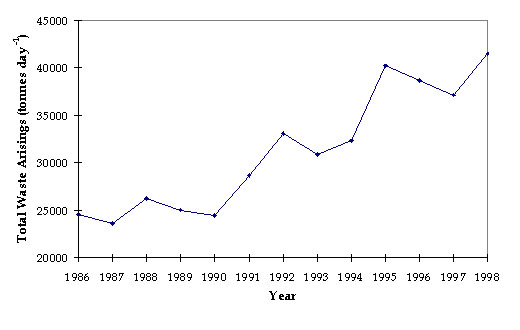Executive Summary of Environmental Baseline Report
|
SECTION 3 NATURAL RESOURCES CAPITAL STOCK
|
3.4 |
WASTE DISPOSAL AND ARISINGS |
|
|
|
|
|
|
3.4.1 |
Baseline Resources and Key Pressures |
|
|
|
|
|
Construction and Demolition (C&D) waste and Municipal Solid Waste (MSW) are the two most significant waste streams in Hong Kong. The total waste arisings (MSW and C&D) has been reported to increase steadily during the previous 15 year period (Figure 3.4a). Although some C&D waste is diverted to public filling areas (the amount diverted depends on availability of such areas), the remainder along with most MSW is disposed of to landfill. Most of the SAR's chemical waste is disposed of at the Chemical Waste Treatment Centre at Tsing Yi. Due to a growing and increasingly affluent population, rates of domestic municipal solid waste are steadily growing and this trend is projected to continue (eg domestic waste arisings are predicted to double 1997 levels by 2015).
Figure 3.4a: Total Waste Arisings (MSW and C&D) in Tonnes per Day

Landfill space is becoming severely restricted and the Government's Waste Reduction Framework Plan (WRFP), together with various waste reduction initiatives, have been developed to address these problems. Targets have been set for recycling and waste reduction - including reducing the amount of MSW requiring final disposal in 2007 by 40% - in order to encourage resource efficiency and increase the lifespan of existing landfills. Nevertheless, in the longer term, alternative treatment methods for Hong Kong's waste, including the presently mooted waste-to-energy schemes will need to be adopted.
Waste disposal also presents environmental pollution issues for example from illegal waste tipping and from land contamination associated with historical industrial and commercial pollution.
|
|
|
|
|
|
|
     |